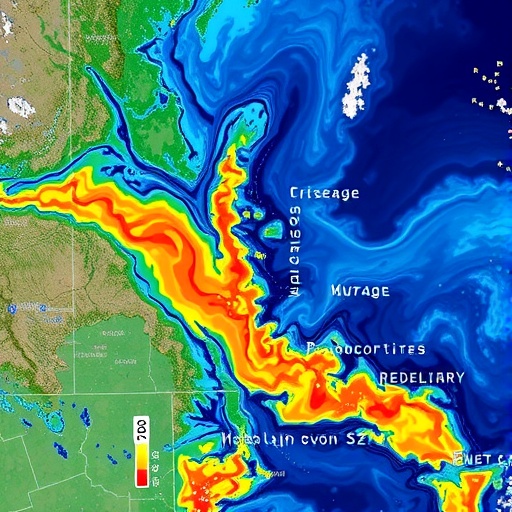Recent advancements in remote sensing technologies have paved the way for more accurate estimation of surface soil moisture, a crucial variable for agricultural productivity, water resource management, and climate modeling. In a groundbreaking study led by researchers Wu, D., Li, Y., and Ye, S., the team has employed innovative methodologies that leverage the unique capabilities of dual-satellite spectral fusion in conjunction with a detailed understanding of soil properties. This convergence of satellite technology and soil science marks a significant leap forward in our quest to understand and monitor soil moisture dynamics effectively.
Soil moisture plays a vital role in modulating the Earth’s land surface processes, including hydrology, meteorology, and ecology. Accurate measurements of soil moisture are essential for various applications ranging from agricultural management to flood prediction and drought assessment. Traditional methods of assessing soil moisture often rely on ground-based measurements that tend to be localized and expensive. As such, the integration of remote sensing offers a promising alternative for obtaining high-resolution soil moisture data over larger geographic scales.
The researchers implemented a dual-satellite approach that utilizes data from multiple satellite missions to enhance the spectral information available for soil moisture estimation. This technique fosters a more comprehensive understanding of the subtle variations in soil moisture across different landscapes by capitalizing on the strengths of each satellite’s observational capabilities. Remote sensing platforms like the European Space Agency’s Sentinel-1 and NASA’s SMAP (Soil Moisture Active Passive) are pivotal in the fabric of this innovative methodology, providing high spatial and temporal resolutions essential for precision monitoring.
Essentially, the study investigated how the unique spectral signatures captured by different satellites could be fused to yield rich, multidimensional datasets. By combining the empirical soil moisture data with advanced machine learning algorithms, the researchers developed a model that vastly improves upon traditional estimation techniques. Machine learning allows for complex relationships within soil properties—such as texture, density, and organic matter content—to be analyzed, leading to more robust estimates of soil moisture content.
Fundamentally, soil properties influence the ability of soil to retain moisture, which is key to effective modeling. The researchers assessed various soil properties including granulometry, organic content, and water retention capacity. These characteristics play an integral role in determining how moisture varies spatially and temporally. By incorporating these parameters into their dual-satellite framework, the team was able to construct predictive models that are responsive to localized conditions. This approach not only enhances accuracy but also provides actionable insights tailored to specific regions.
Additionally, the dual-satellite spectral fusion approach opens up avenues for integrating climate data and predictive analytics. By aligning soil moisture estimates with seasonal and geographical climatic variations, the team could evaluate the potential impacts of climate change on soil moisture patterns. This comprehensive assessment is crucial for formulating adaptive strategies in agriculture, forestry, and land management practices as global climatic conditions continue to evolve.
The ramifications of improved soil moisture estimation extend into the realms of food security and environmental sustainability. With enhanced accuracy in soil moisture monitoring, farmers can optimize irrigation practices, thereby promoting water conservation and crop yield efficiency. Moreover, it assesses drought risk more effectively, which is invaluable in regions where water scarcity presents an increasing challenge to agricultural operations.
Moreover, improved soil moisture data supports the modeling of stormwater runoff and flood risk. During heavy rainfall events, knowing the moisture content of soils can help predict the infiltration rates and guide urban planning initiatives to mitigate flooding risks. As cities around the globe grapple with the challenges of urbanization and climate change, accurate soil moisture data becomes a cornerstone of resilient infrastructure planning.
This innovative technique demonstrates the synergy achieved between technology and natural sciences. As researchers exploit new advances in both remote sensing technologies and data analytics, the findings of this study highlight a critical pathway toward more informed decision-making in environmental and agricultural management. The study underscores the importance of interdisciplinary research efforts that include soil scientists, remote sensing experts, and climate modelers, all working collaboratively to address the pressing challenges posed by a rapidly changing world.
In summary, the work of Wu, D., Li, Y., and Ye, S. stands as a beacon of progress, showcasing how advanced methodologies in soil moisture estimation can yield far-reaching benefits across a multitude of fields. With a growing emphasis on sustainable practices in agriculture and land management, the integration of dual-satellite spectral fusion represents a vital step forward in our understanding and stewardship of natural resources.
As we proceed into an era increasingly defined by data, the implications of this research extend well beyond academic curiosity; they serve as a wake-up call for policymakers, farmers, and stakeholders to leverage technological innovations for solving practical challenges. The fusion of satellite data with soil properties may very well transform not just how we monitor soil moisture, but also how we adapt to the myriad challenges posed by climate change.
The future of soil moisture estimation—one that is more precise and integrated with contemporary agricultural practices and environmental monitoring—seems promising thanks to these pioneering research efforts. It drives home an essential truth: in the vast and complex tapestry of our planet, bridging interdisciplinary knowledge and leveraging the latest technological advancements can lead to sustainable solutions that benefit humanity and the environment alike.
Subject of Research:
Soil moisture estimation using dual-satellite spectral fusion and soil properties.
Article Title:
Improved estimation of surface soil moisture based on soil properties and dual-satellite spectral fusion.
Article References:
Wu, D., Li, Y., Ye, S. et al. Improved estimation of surface soil moisture based on soil properties and dual-satellite spectral fusion.
Environ Monit Assess 197, 1064 (2025). https://doi.org/10.1007/s10661-025-14491-8
Image Credits: AI Generated
DOI: 10.1007/s10661-025-14491-8
Keywords: Soil moisture, remote sensing, satellite data, dual-satellite spectral fusion, machine learning, climate change, agriculture, environmental management.




